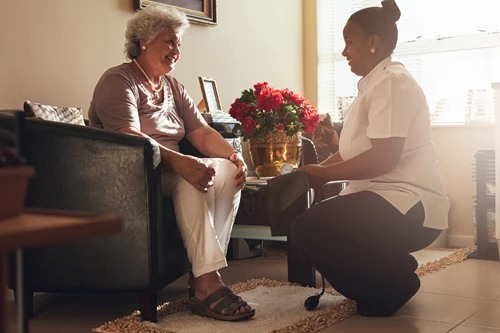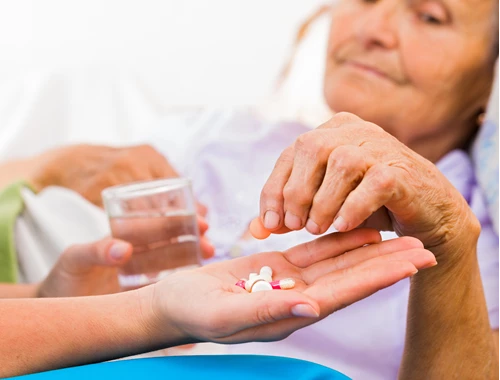The 5 R’s of Medication Explained
Nurses, care home managers and care home staff who have received adequate medication training are responsible for medication administration. As with many nursing interventions, there are risks involved.
The R’s of medication administration were put in place to protect the interests of both those administering medicine and the person taking medicine/s, alongside reducing the harm that can be caused by medication errors. To help you gain a better understanding, we’ve put together this guide explaining the 5 R’s of medication safety.
What is Medicines Management?
Medicines management, which is also known as medicines optimisation, has been summarised by the Medicines and Healthcare Products Regulatory Agency as ‘the clinical, cost-effective and safe use of medicines to ensure people get the maximum benefit from the medicines they need, while at the same time, minimising potential harm.’
This is reaffirmed by the National Institute for Health and Care Excellence (NICE) as ‘the safe and effective use of medicines to enable the best possible outcomes.’
Successful medication management practices place the person receiving care as the primary focus, which leads to better-targeted care with well-informed individuals. It seeks to address medication-related issues and optimise the use of medicines by offering advice on prescriptions, monitoring, repeat prescriptions and education and training on prescribing and the use of medicines.

Understanding the ‘5 Rights’ of Medication Safety
The key role of a nurse in a care or nursing home is to administer medication. This may be in a busy or unfamiliar environment where risks can occur if the correct procedure isn’t followed. By following a system like the ‘5 rights,’ nurses, or care workers with sufficient training to administer medicines, are more likely to consider the key aspects of medicine safety which will reduce the likelihood of errors. The ‘5 rights’ of medication safety are:
1. The Right Person
In a care home, most residents won’t be wearing name bands and they will have access to many areas of the building. In some cases, you will be able to check the name on the prescription and wristband. However, in an ideal situation, you should use at least 2 identifiers. To ensure that you’re medicating the right patient, you should ask for their name rather than tell them, so they can identify themselves.
2. The Right Drug
The right drug or medication is vital when treating patients or supporting residents. You should look at the name of the medication itself rather than the brand name. Brand names should be avoided as they can lead to confusion. You should also check the expiry date and the prescription. Make sure that all medications, especially antibiotics, are reviewed regularly.
3. The Right Dose
When working out the dose for an individual, you should double-check the prescription to ensure you’re administering the correct amount of the drug. Ideally, you should confirm the appropriateness of the recommended dose with local guidelines or using the BNF. If necessary, calculate the dose yourself and get another nurse to do the same thing to ensure you’re working it out accurately.
4. The Right Route
Once again, make sure you check the order and the appropriateness of the route that’s been prescribed for the person. You should confirm that the person can safely receive or take the medication by the ordered route. The right route can also apply to the administration of the medication. For example, is it topical or does it require an injection? Or does it need to be swallowed or inserted?
5. The Right Time
When administering prescribed medication, you should always double-check the frequency and if you’re giving it to the person at the right time. For example, some medications should be taken on a full or empty stomach or within a certain timeframe apart. This leads us to the next step, which is to check when the last dose was given to ensure that you’re not medicating them too soon or too late.

Additional ‘5 Rights’ to Consider
Experts have called for the ‘5 rights’ to be expanded to 10 rights of medication administration. This is because 10% of individuals experience unwanted reactions or side effects and research shows that research on medication errors show that 60% of all drug errors are due to administration errors. The R’s of medication exist to reduce the harm caused by medication errors and protect the person’s interests. The additional ‘5 rights’ to consider include:
6. Right Documentation
The medication process requires precise, clear and transparent documentation in people’s care records. If documentation is incorrect or incomplete, it could lead to inappropriate clinical decision-making and adverse reactions. So, you should ensure you have signed for the medication AFTER you have administered it and that it’s been prescribed correctly with an appropriate start and end date.
7. Right to Refuse
Before you administer medication, you should make sure that you have the person’s consent to do so. You must remember that people have the right to refuse medication if they have the capacity to do so. If people lack the capacity to make an informed decision, for example, the patient suffers from dementia or a mental health condition, then you have the right to medicate without consent.
8. Right Assessment
Before you administer medication, you should take an assessment to check that the person actually needs the medication. You should also confirm that there aren’t any contraindications if the individual is taking multiple medicines. Finally, if required, you should carry out baseline observations, which are behavioural assessments that are increasing in popularity.
9. Right Evaluation
You should ensure the medication is working the way it should by carrying out evaluations. The medications must be reviewed regularly and ongoing observations should be carried out if required. Any medications given previously should be checked, alongside the diet of the person being cared for or supported. The expiry date of the medication should also be verified before it’s administered.
10. Right Patient Education
You should make sure that the person taking the medication understands what the medication is for. The more knowledge they have, the better decisions they will make and they may become more cooperative when administering medication. You should also make them aware of any side effects or reactions they may experience and when to contact a healthcare professional.
Timing the Patient’s Medication
With so many medications and patients or residents to keep track of, it’s easy for things to get disorganised without the right kind of routine in place. As well as being aware of the dosing frequency, the time of day, meals, and bedtimes all need to be taken into consideration. Some tips you can follow to ensure you’re keeping track of which medicine to give and when to give it include:
Using a schedule or medication log
This can be very helpful for drugs that require more than one dose throughout the day. A schedule or online medication log can be used as a visual or electronic reminder of the best time to administer the next dose.
Set an alarm
Many of us have a mobile phone, a smartwatch or even a regular watch on us during a work day, so setting an alarm or another kind of reminder to help you stay on track and remember when the next dose is due is highly recommended.
Communicate clearly
In most cases, medication errors, such as missed or double dosing, are due to poor communication amongst care home staff. To avoid this, you should keep a physical schedule handy that can be used by all the nurses. Just make sure you keep it up to date throughout the day.

Start Managing Your Medication
Having medication management software in place can help you monitor the critical action of medication management, which is vital for any care provider.
There are a host of advantages of an electronic medication system, such as reducing the risk of medication errors, focusing on the resident’s individual needs and getting immediate access to key medication information, to name a few.
If you want to know more about how a medication management system could be used to benefit your care or nursing home, we have the perfect solution for you. Discover our complete medication management solution, which includes eMAR. We know how effective it can be and we aim to help others gain the same knowledge so they can start benefiting too.

